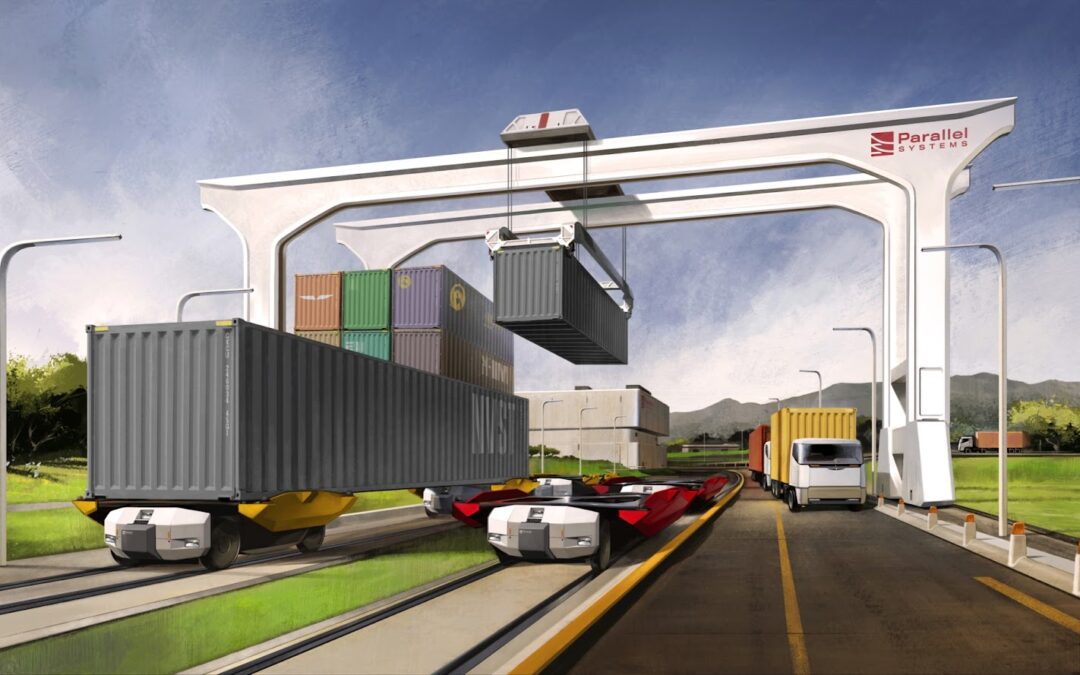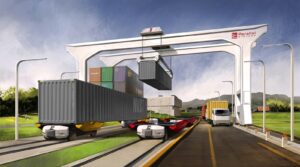Illustration of Parallel Systems autonomous battery-electric rail vehicles at a microterminal
By Stas Margaronis
Parallel Systems, a company founded by former SpaceX engineers to create autonomous battery-electric rail vehicles, says it can relieve truck congestion at ports and increase short-haul rail with its zero-emission container carriers.
The company showcased its rail vehicles to attendees at Intermodal Expo in Long Beach, California in September.
Autonomous Rail Cars Could Reduce Harbor Trucking
In an interview, Matt Soule, Co-founder and CEO, Parallel Systems, said he sees potential for relieving harbor trucking congestion at ports such as the Ports of Los Angeles and Long Beach that might impact 50,000 containers per year.
This can be achieved by increasing short-distance moves of containers to and from the ports using autonomous battery-powered rail cars instead of diesel trucks:
“We are looking to make that drayage more productive. So, in terms of doing three turns a day at the port, we want to be able to increase those numbers to five or six by getting in and out of the terminal faster and drive fewer miles to that customer. People want to see that this works before they make plans to use this service … “
The Southern California Ports Market
The market in Southern California could be considerable:
“The architecture allows our vehicle to bring freight much closer to the customer and keep that drayage cost lower. We have customers interested in making their own smaller warehouses to accommodate our rail architecture and support a rail drayage service that would not be possible with conventional rail technology. This is like a port adjacent to a warehouse so rather than having a truck dray the container from the port you could use our railcars to replace the trucks and do a steady volume of about 50,000 containers a year. Our platform is something that could serve that.”
He added:
“In Southern California, there are thousands of trucks delivering containers to transload facilities, warehouses and rail yards that are delivering the containers East of the Rockies. We could provide the drayage to those facilities including intermodal rail facilities.”
Zero Emission Container Carriers
The Ports of Los Angeles and Long Beach’s Clean Air Action Plan calls for zero-emission trucks by 2035.[1] Parallel Systems’ container carriers could provide zero-emission battery-powered vehicles to replace trucks:
“Long haul trucking remains energy intensive and that’s why electrifying long haul trucks will be hard. And that’s because you have a vehicle platform that already has a strict weight limit. Thus, the battery system for the truck is going to have to be big and heavy. So, what we’re developing is something that has a lot of those constraints relaxed because rail uses about a quarter of the energy of trucks. So, the battery for the rail only has to be a quarter of the size of what you would need for the truck. And the other advantage of rail is that it has tremendous weight capacity. So, we are using battery chemistries that are inexpensive and have a long life. Remember each axle can carry the weight of a class 8 truck. … So, if you look at two fully loaded containers on top of that configuration, we have 150,000 pounds to work with and we are well below that.”
Using Existing Traffic Control Systems
The Parallel Systems rail cars will be able to function on existing traffic control systems used by the railroads:
“We are working to develop our vehicle with software that is compatible. Our system will ask for track authority and when we say we’re autonomous, we’ll be autonomous within the track authority we’ve been granted. We are also working through PTC (Positive Rail Control) integration so we are designing our software to be compatible with our train control systems. We are striving to do the testing to meet those goals. Even though our position is to shift truck miles to rail, we have had some good conversations with trucking companies because in terms of drayage we think our technology could be complementary.”
Short Distance Rail Services Can Be More Economical
Short-distance railroads services could be more economical using battery-powered systems:
“There is also the possibility that the railroad might want to offer a new service to Salt Lake City or Denver but does not want to invest the large-scale cost of supporting the new service. We could be a low-cost … means of exploring the viability of that trial solution. Reno/Sparks to the Port of Oakland might be another possibility. We are designing the vehicles to accommodate the physical rail infrastructure that is there. We have been doing dynamic modeling under different conditions to see how the vehicle handles. While it is an autonomous vehicle this vehicle is playing by the same rules as the rail freight system does today.”
Creating New Rail Services
Soule said start-up costs for new rail services can be much less than for conventional diesel-powered rail service. In recent years, major railroads have cutback services and laid off thousands of employees to lower costs and increase profitability when applying so-called Precision Scheduled Railroading (PSR) methods:
“Precision scheduled railroading has created conditions in which smaller volume routes do not generate high enough revenues. For the smaller routes, the customer wants at least one ramp time per day. To support high volume rail routes, requires rail terminals located in places that can support high rail volumes that are likely to be distant from smaller customers. So, when the drayage cost is too high, it’s just not enough.”
He adds:
“It could take hundreds of millions of dollars to open a terminal in a new market, which means companies need to be willing to make a significant financial commitment … Our system unlocks the ability to open smaller terminals that allow the customers to pilot a new intermodal lane at a fraction of the cost. This addresses a huge pain point and helps better serve the freight industry by allowing companies to dip their toe in the water before jumping all in.”
A company press release notes: “Traditional rail terminals have to be large enough to service long trains, and are each built on hundreds of acres of land. These large terminals impact overall efficiency as they are expensive, remote, and result in slower delivery times. Parallel’s proprietary architecture allows for smaller, cleaner, and less expensive terminals that can be built closer to shippers and customers, effectively opening new markets and reducing last-mile delivery costs.”
Braking Systems
The autonomous rail cars will not be using conventional braking systems:
“One of the things that is different about our technology is that we are not using legacy freight train brakes. We are developing a redundant electrohydraulic braking system that can adapt to real conditions to stop a vehicle …. That means that our system doesn’t need to perceive down the track as the legacy rail freight braking system on a locomotive. So, our intention is to react more quickly to the environment around us. It is not a good use of containers to move a single container along the rail network and nor is it the most energy efficient …One of the reasons why we prefer ten as the minimum platoon size is that your energy benefits… because your effective energy drag is quite low and because you are sharing work mechanically through this bumper system. So, when slowing down, the first vehicle slows down and the vehicles behind sense this and slow down their tractive effort to keep that force of control. Braking is detected by seeing a force increase in those bumpers. And the vehicles behind the lead vehicle will slow down as response to that increasing force.”
No Coupling
Also, the system does not utilize conventional coupling so that drag is reduced:
“Every vehicle has a traction motor, battery, sensors, computers and radios. We don’t have a conventional coupler… we have a bumper interface and one of the reasons we are so energy efficient is that we have a pretty high drag on the first container but the containers behind it are drafting so there is very little drag. We actually push from the rear of this platoon through this bumper system to amortize the drag of that first container.
New Faster Battery Charging
Parallel’s plan for battery charging “… is to integrate charging into the terminals because you fundamentally have to dwell to load and unload your equipment. So, the dwell time works well for the time you need to charge. And you index over charging pads between the rails. So, we charge while you’re loading and unloading your platoon. The charging cost is also less than the truck because the battery is smaller and (the) charger is smaller than (for) the trucks. You can also be very predictive about the utilization of this charging infrastructure… because you can predict how much service you are going to get per year. So, when you have the rail system there’s a lot less uncertainty. And this is a very favorable place to deploy charging infrastructure because of those economic realities. And… nobody has to plug anything in. “
GPS
Soule explains that: “We have localization onboard, and we have GPS, cameras and wheel odometry (Odometry is the use of motion sensors to determine the robot’s change in position relative to some known position). For example, if a robot is traveling in a straight line and if it knows the diameter of its wheels, then by counting the number of wheel revolutions it can determine how far it has traveled. This tells us where we are in the world. In terms of supervision, we are autonomous but if we encounter an exception, we expect to have a human in the loop to figure out how to disposition that.”
Still In Testing Mode
Soule cautions that the Parallel rail cars are still in the testing stage:
“We’re on our second-generation vehicle which is the first vehicle that we have designed from the ground up. This is the vehicle as the steppingstone to what would be a commercially viable vehicle. It’s hard to forecast when that commercial vehicle will be ready for service. It’s vital that we get this second-generation vehicle out in the field and tested. So, our second-generation vehicle is currently at our own outdoor test facility in Southern California … where we will be testing for the next six months. There will be a third-generation vehicle but we are not at the point when we can say when that will be available. We have built two of the second-generation vehicles and we are building two more right now. We have built one pair and are going to build a second pair and we’ll build two more pairs in the next six months. We are building our own camera-based system. We have done some demonstrations live showing that obstacles will trigger the system and the system will correctly stop but we’re not calling it ready yet.”
FOOTNOTE
[1] https://www.longbeachlocalnews.com/2022/09/14/port-of-long-beach-previews-path-to-zero-emissions%EF%BF%BC/


